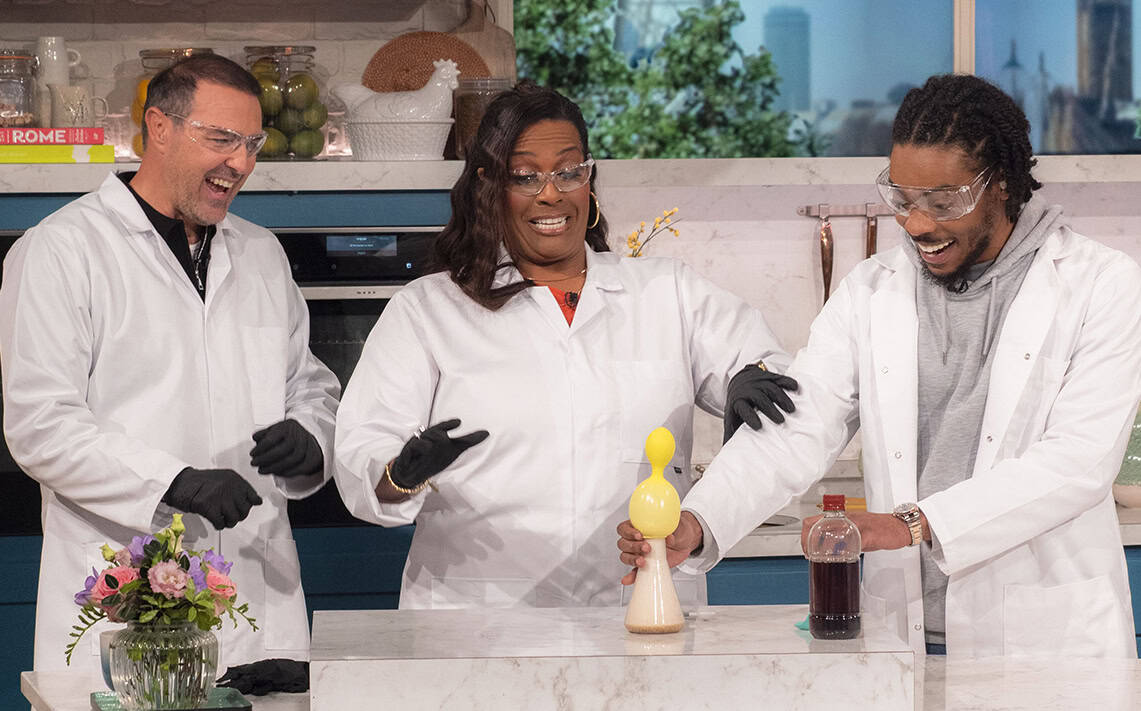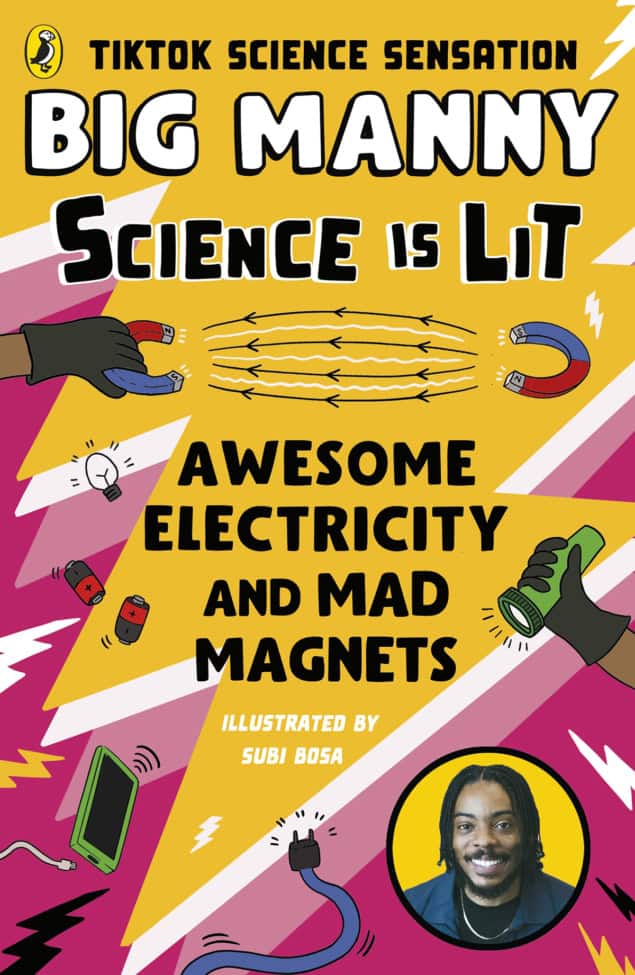When lockdown hit, school lab technician Emanual Wallace started posting videos of home science experiments on social media. Now, as Big Manny, he’s got over three million followers on Instagram and TikTok; won TikTok’s Education Creator of the Year 2024; and has created videos with celebrities like Prince William and Brian Cox. Taking his science communication beyond social media, he’s been on CBBC’s Blue Peter and Horrible Science; has made TV appearances on shows like This Morning and BBC Breakfast; and has even given talks at Buckingham Palace and the Houses of Parliament.
But he’s not stopped there. Wallace has also recently published a second book in his Science is Lit series, Awesome Electricity and Mad Magnets, which is filled with physics experiments that children can do at home. He talks to Sarah Tesh about becoming the new face of science communication, and where he hopes this whirlwind journey will go next.

What sparked your interest in science?
I’ve always been really curious. Ever since I was young, I had a lot of questions. I would, for example, open up my toys just so I could see what was inside and how they worked. Then when I was in year 8 I had a science teacher called Mr Carter, and in every lesson he was doing experiments, like exciting Bunsen burner ones. I would say that’s what ignited my passion for science. And naturally, I just gravitated towards science because it answered all the questions that I had.
Growing up, what were the kind of science shows that you were really interested in?
When I was about 11 the show that I used to love was How it’s Made? And there’s a science creator called Nile Red – he creates chemistry videos, and he inspired me a lot. I used to watch him when I was growing up and then I actually got to meet him as well. He’s from Canada so when he came over, he came to my house and we did some experiments. To be inspired by him and then to do experiments with him, that was brilliant. I also used to watch a lot of Brian Cox when I was younger, and David Attenborough – I still watch Attenborough’s shows now.
You worked in a school for a while after your degrees at the University of East London – what made you go down that path rather than, say, staying in academia or going into industry?
Well, my bachelor’s and master’s degrees are in biomedical science, and my aspiration was to become a biomedical scientist working in a hospital lab, analysing patient samples. When I came out of university, I thought that working as a science technician at a school would be a great stepping stone to working as a biomedical scientist because I needed to gain some experience within a lab setting. So, the school lab was my entry point, then I was going to go into a hospital lab, and then work as a biomedical scientist.

But my plans have changed a bit now. To become a registered biomedical scientist you need to do nine months in a hospital lab, and at the moment, I’m not sure if I can afford to take nine months off from my work doing content creation. I do still want to do it, but maybe in the future, who knows.
What prompted you to start making the videos on social media?
When I was working in schools, it was around the time of lockdown. There were school closures, so students were missing out on a lot of science – and science is a subject where to gain a full understanding, you can’t just read the textbook. You need to actually do the experiments so you can see the reactions in front of you, because then you’ll be more likely to retain the information.
I started to notice that students were struggling because of all the science that they had missed out on. They were doing a lot of Google classrooms and Zoom lessons, but it just wasn’t having the full impact. That’s when I took it upon myself to create science demonstration videos to help students catch up with everything they’d missed. Then the videos started to take off.
How do you come up with the experiments you feature in your videos? If you’re hoping to help students, do you follow the school curriculum?
I would say right now there’s probably three main types of videos that I make. The first includes experiments that pertain to the national curriculum – the experiments that might come up in, say, the GCSE exams. I focus on those because that’s what’s going to be most beneficial to young people.
Secondly, I just do fun experiments. I might blow up some fruit or use fire or blow up a hydrogen balloon. Just something fun and visually engaging, something to get people excited and show them the power of science.
And then the third type of video that I make is where I’m trying to promote a certain message. For example, I did a video where I opened up a lithium battery, put it into water and we got an explosion, because I wanted to show people the dangers of not disposing of batteries correctly. I did another one where I showed people the effects of vaping on the lungs, and one where I melted down a knife and I turned it into a heart to persuade people to put down their knives and spread love instead.
Who would you say is your primary audience?
Well, I would say that my audience is quite broad. I get all ages watching my videos on social media, while my books are focused towards primary school children, aged 8 to 12 years. But I’ve noticed that those children’s parents are also interested in the experiments, and they might be in their 30s. So it’s quite a wide age range, and I try to cater for everyone.
In your videos, which of the sciences would you say is the easiest to demonstrate and which is the hardest?
I’d say that chemistry is definitely the easiest and most exciting because I can work with all the different elements and show how they react and interact with each other. I find that biology can sometimes be a bit tricky to demonstrate because, for example, a lot of biology involves the human body – things like organ systems, the circulatory system and the nervous system are all inside the body, while cells are so small we can’t really see them. But there’s a lot that I can do with physics because there’s forces, electricity, sound and light. So I would say chemistry is the easiest, then physics, and then biology is the hardest.
Do you have a favourite physics experiment that you do?
I would say my favourite physics experiment is the one with the Van de Graff generator. I love that one – how the static electricity makes your hair stand up and then you get a little electric shock, and you can see the little electric sparks.
You’re becoming a big name in science communication – what does an average day look like for you now?
On an average day, I’m doing content creation. I will research some ideas, find some potential experiments that I might want to try. Then after that I will look at buying the chemicals and equipment that I need. From there, I’ll probably do some filming, which I normally just do in my garden. Straight after, I will edit all the clips together, add the voiceover, and put out the content on social media. One video can easily take the whole day – say about six or seven hours – especially if the experiment doesn’t go as planned and I need to tweak the method or pop out and get extra supplies.
In your videos you have a load of equipment and chemicals. Have you built up quite a laboratory of kit in your house now?
Yeah, I’ve got a lot of equipment. And some of it is restricted too, like there’s some heavily regulated substances. I had to apply for a licence to obtain certain chemicals because they can be used to make explosives, so I had to get clearance.
What are you hoping to achieve with your work?
I’ve got two main goals at the moment. One of them is bringing science to a live audience. Most people, they just see my content online, but I feel like if they see it in person and they see the experiments live, it could have an even bigger impact. I could excite even more people with science and get them interested. So that’s one thing that I’m focusing on at the moment, getting some live science events going.
I also want to do some longer-form videos because my current ones are quite short – they’re normally about a minute long. I realize that everyone learns in different ways. Some people like those short, bite-sized videos because they can gain a lot of information in a short space of time. But some people like a bit more detail – they like a more lengthy video where you flesh out scientific concepts. So that’s something that I would like to do in the form of a TV science show where I can present the science in more detail.
The post Making science go boom: Big Manny’s outreach journey appeared first on Physics World.

